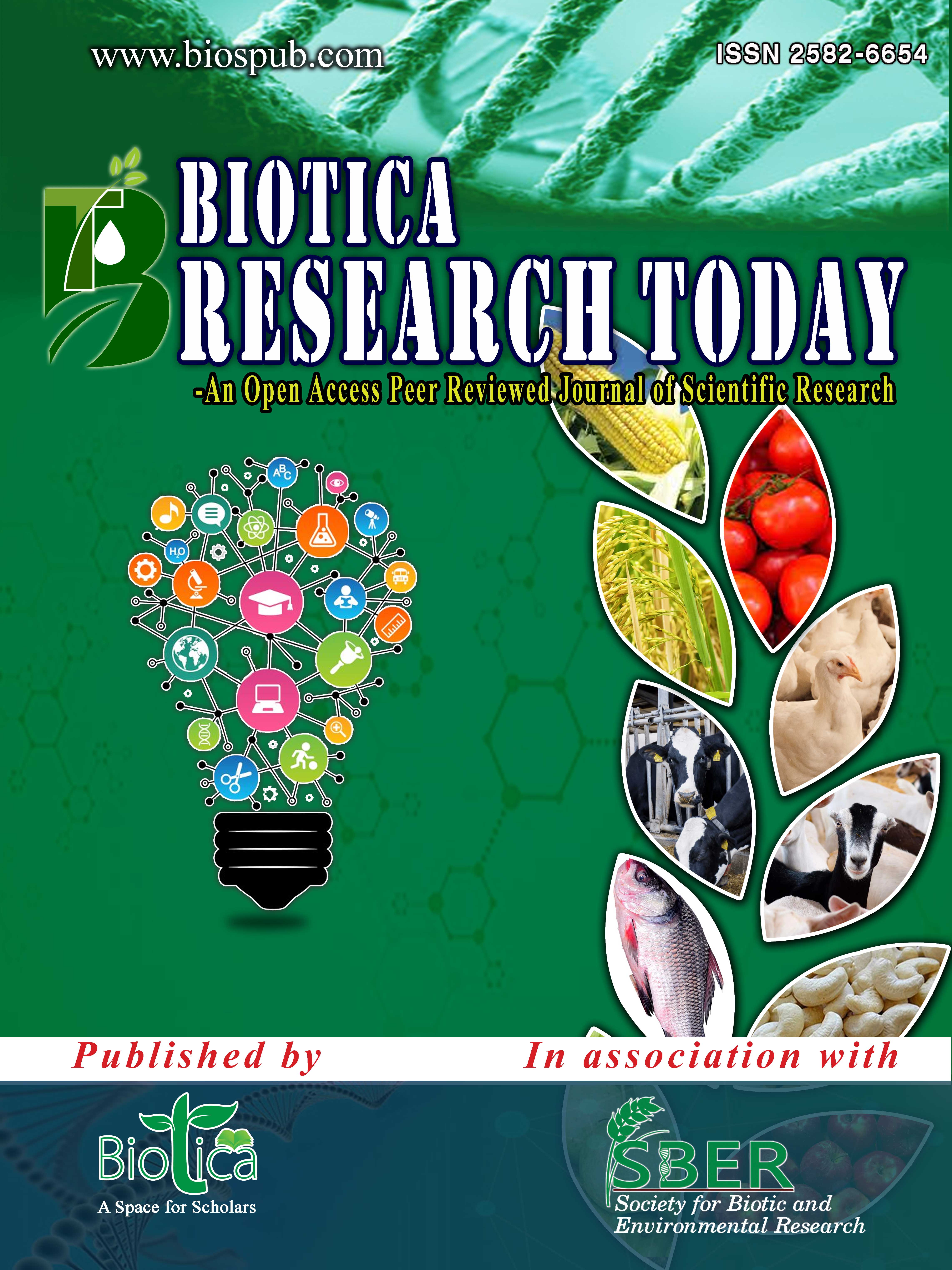Botanicals as a Source of Nanomaterial for Pest and Disease Management
DOI:
https://doi.org/10.54083/PHA/1.3.2023/96-101Keywords:
Green synthesis, Nanomaterials, Nanotechnology, PhytosynthesisAbstract
Sustainable food production for a rapidly growing human population is one of the major challenges faced by the agriculture sector globally. Plant pests and pathogens cause significant reductions in crop production, with estimated global losses of 20-40% year-1, resulting in an increased use of environmentally toxic pesticides & fertilizers. The growing numbers of studies in nanotechnology are producing novel applications in many fields of science, especially in plant biotechnology and agriculture. Nanomaterials (NMs) have been used in breakdown of pollutants and reported worldwide for several different environmental applications. They play an important role in agriculture as nano-fertilizers and nano-pesticides, prepared by many methods such as physical, green synthesis or chemical synthesis methods. Green synthesis involves use of biological resources as microorganisms or plant extracts and doesn’t permit the use of any toxic chemicals, hence less bio-hazardous. Rate of reduction of metal ions using phytosynthesis has been observed to be much faster than microbial synthesis. Thus, it is considered as an accessible alternative for large scale production of nanomaterials, without use of chemicals. Phytosynthesized nanomaterials show excellent antibacterial effects, antifungal effects and anti-pest activity. Ocimum sanctum, Azadiracta indica, Paederia foetida, etc. had been successfully reported to be used in synthesis of many NMs of silver, gold, zinc, etc. Botanical nanomaterials offer considerable potential for increasing agricultural productivity and protection while reducing negative impacts on the environment and human health simultaneously.
Downloads
References
Akhter, S.M.H., Mohammad, F., Ahmad, S., 2016. Plant mediated green synthesis of metal nanoparticles for applications in medicine. Journal of Nanotechnology in Diagnosis and Treatment 4, 15-24. DOI: 10.12974/2311-8792.2016.04.3. DOI: https://doi.org/10.12974/2311-8792.2016.04.3
Bhuyan, B., Paul, A., Paul, B., Dhar, S.S., Dutta, P., 2017. Paederia foetida Linn. promoted biogenic gold and silver nanoparticles: Synthesis, characterization, photocatalytic and in vitro efficacy against clinically isolated pathogens. Journal of Photochemistry and Photobiology B: Biology 173, 210-215. DOI: 10.1016/j.jphotobiol.2017.05.040. DOI: https://doi.org/10.1016/j.jphotobiol.2017.05.040
de Oliveira, J.L., Campos, E.V.R., Bakshi, M., Abhilash, P.C., Fraceto, L.F., 2014. Application of nanotechnology for the encapsulation of botanical insecticides for sustainable agriculture: Prospects and promises. Biotechnological Advances 32(8), 1550-1561. DOI: 10.1016/j.biotechadv.2014.10.010. DOI: https://doi.org/10.1016/j.biotechadv.2014.10.010
Dutta, P., Kaman, P., Kaushik, H., Boruah, S., 2015. Biotechnological and nanotechnological approaches for better plant health management. Trends in Biosciences 8(22), 6051-6065.
Dutta, P., Kaman, P.K., 2017. Nanocentric plant health management with special reference to silver. International Journal of Current Microbiology and Applied Sciences 6(6), 2821-2830. DOI: https://doi.org/10.20546/ijcmas.2017.606.336
El Shafey, A.M., 2020. Green synthesis of metal and metal oxide nanoparticles from plant leaf extracts and their applications: A review. Green Processing and Synthesis 9(1), 304-339. DOI: 10.1515/gps-2020-0031. DOI: https://doi.org/10.1515/gps-2020-0031
Gogate, S., Rahman, S., Dutta, P., 2018. Efficacy of synthesized silver nanoparticles using Ocimum sanctum (L.) leaf extract against Corcyra cephalonica (S.). Journal of Entomology and Zoology Studies 6(3), 1149-1155.
Herlekar, M., Barve, S., Kumar, R., 2014. Plant-mediated green synthesis of iron nanoparticles. Journal of Nanoparticles 2014, 1-9. DOI: 10.1155/2014/140614. DOI: https://doi.org/10.1155/2014/140614
Husen, A., Siddiqi, K.S., 2014. Phytosynthesis of nanoparticles: concept, controversy and application. Nanoscale Research Letters 9, 229. DOI: 10.1186/1556-276X-9-229. DOI: https://doi.org/10.1186/1556-276X-9-229
Jeyaraj, M., Gurunathan, S., Qasim, M., Kang, M.H., Kim, J.H., 2019. A comprehensive review on the synthesis, characterization, and biomedical application of platinum nanoparticles. Nanomaterials 9(12), 1719. DOI: 10.3390/nano9121719. DOI: https://doi.org/10.3390/nano9121719
Li, X., Xu, H., Chen, Z., Chen, G., 2011. Biosynthesis of nanoparticles by microorganisms and their applications. Journal of Nanomaterials 2011, 1-16. DOI: 10.1155/2011/270974. DOI: https://doi.org/10.1155/2011/270974
Love, A.J., Makarov, V.V., Sinitsyna, O.V., Shaw, J., Yaminsky, I.V., Kalinina, N.O., Taliansky, M.E., 2015. A genetically modified tobacco mosaic virus that can produce gold nanoparticles from a metal salt precursor. Front Plant Sciences 6, 1-10. DOI: 10.3389/fpls.2015.00984. DOI: https://doi.org/10.3389/fpls.2015.00984
Murthy, H.C.A, Abebe, B., Prakash, C.H., Shantaveerayya, K., 2018. A review on green synthesis of Cu and CuO nanomaterials for multifunctional applications. Material Science Research India 15(3), 279-295. DOI: 10.13005/msri/150311. DOI: https://doi.org/10.13005/msri/150311
Pandey, G., Jain, P., 2020. Assessing the nanotechnology on the grounds of costs, benefits, and risks. Beni-Suef University Journal of Basic and Applied Science 9, 63. DOI: 10.1186/s43088-020-00085-5. DOI: https://doi.org/10.1186/s43088-020-00085-5
Rauf, M.A., Oves, M., Rehman, F.U., Khan, A.R., Husain, N., 2019. Bougainvillea flower extract mediated zinc oxide’s nanomaterials for antimicrobial and anticancer activity. Biomedicine and Pharmacotherapy 116, 108983. DOI: 10.1016/j.biopha.2019.108983. DOI: https://doi.org/10.1016/j.biopha.2019.108983
Souza, L.R.R., da Rocha Neto, A.C., da Silva, C.R., Franchi, L.P., de Souza, T.A.J., 2019. Green synthesis approaches of nanoagroparticles. In: Nanobiotechnology in Bioformulations. (Eds.) Prasad, R., Kumar, V., Kumar, M. and Choudhary, D. Nanotechnology in the Life Sciences. Springer, New York, pp. 353-380. DOI: 10.1007/978-3-030-17061-5_15. DOI: https://doi.org/10.1007/978-3-030-17061-5_15
Smitha, P.S., Sheeja, T.T., Manju, M., 2020. Green nanoparticles from different plant groups. Chapter 4. In: Phytonanotechnology: Challenges and Prospects. (Eds.) Thajuddin, N. and Mathew, S. Elsevier. pp. 51-70. DOI: 10.1016/B978-0-12-822348-2.00004-8. DOI: https://doi.org/10.1016/B978-0-12-822348-2.00004-8
Villaseñor-Basulto, D.L., Pedavoah, M.M., Bandala, E.R., 2019. Plant materials for the synthesis of nanomaterials: Greener sources. In: Handbook of Ecomaterials. (Eds.) Martínez, L., Kharissova, O. and Kharisov, B. Springer, Cham. pp. 105-121. DOI: 10.1007/978-3-319-68255-6_88. DOI: https://doi.org/10.1007/978-3-319-68255-6_88
Worrall, E.A., Hamid, A., Mody, K.T., Mitter, N., Pappu, H.R., 2018. Nanotechnology for plant disease management. Agronomy 8(12), 285. DOI: 10.3390/agronomy8120285. DOI: https://doi.org/10.3390/agronomy8120285
Zhang, Y.J., Gan, R.Y., Li, S., Zhou, Y., Li, A.N., Xu, D.P., Li, H.B., 2015. Antioxidant phytochemicals for the prevention and treatment of chronic diseases. Molecules 20(12), 21138-21156. DOI: 10.3390/molecules201219753. DOI: https://doi.org/10.3390/molecules201219753
Downloads
Published
How to Cite
Issue
Section
License
Copyright (c) 2023 Plant Health Archives

This work is licensed under a Creative Commons Attribution-NonCommercial-NoDerivatives 4.0 International License.
Submission of a manuscript implies that when the manuscript is accepted for publication, the authors agree to automatic transfer of the copyright to the publisher (or grant the Publisher exclusive publication and dissemination rights). The Biotica, as the publisher, has the right to enter into any agreement with any organization in India or abroad engaged in reprography, photocopying, storage and dissemination of information contained in this journal. The Biotica has no objection in using the material, provided the information is being utilized for academic purpose but not for commercial use. Due credit line should be given to Biotica where information will be utilized.









 |
|




